Recipe, pages 140-143.
(originally attempted in November 2009, then in July 2010…)
Although this hopped-up caprese salad looks so snail-cute and easy, TOMATO, Mozzarella, Many Complementary Flavors is in reality a mean, vicious ego killer. Somewhat akin to the Rabbit of Caerbannog in Monty Python and the Holy Grail.
During this project, I have experienced two kinds emotions: satisfaction at the successful execution of a seemingly impossible recipe, and the utter despair and humiliation of complete failure.
Two things in particular: the tomato-foam-filled mozzarella balloons, and the molasses/saffron jelly rolls. Read on and you’ll see…
Killer bunny kicked my ass. Three times. But I’m posting the little shit anyway.
FAIL FAIL FAIL FAIL FAIL FAIL FAIL FAIL FAIL FAIL FAIL FAIL FAIL
Day One
Mozzarella Curd
Saturday morning I looked and looked for fresh mozzarella curd, but to no avail. A chef friend of mine mentioned he knew another who made his own for local restaurant. But I never did get ahold of the cheesemaker. I traveled around the Little Italy district and noone had it there either. Mozzarella, goat cheese, Buffalo mozzarella, soft burrata — but no mozzarella curd.
So I decided to make my own, and you know what? It was pretty darned fun — and easy!
I ended up with a batch of just the right amount, and had some fresh ricotta as a by-product too.
Ingredients
Reserved mozzarella curd
Tomato Strip
The next day, I bought some beautiful heirloom tomatoes at the local Hillcrest Farmer’s Market in San Diego. If we’re going to get two strips out of each tomato, they’ll have to be the right size, so I got some larger ones than I’d usually pick.
I cut an X into each blossom-end of the tomatoes, and blanched them in boiling water for about half a minute. Then plunged them into an ice water bath. The X shape makes it far easier to peel off the outer skin, or epidermis, of the tomato. I cut off the tops and bottoms, then cut each transversely in two at their “equators.” You can get two out of each large tomato. These will be cut into long strips.
About tomatoes
They’re not a vegetable. Tomatoes (Lycopersicon esculentum) are a fruit. A berry, in fact. And something amazing? They are NOT native to Italy. They’re native to Mexico and South America, and were introduced to Italy and Europe after the discovery of the “New World.”Also, because tomatoes belong to the family Solanaceae, which includes Belladonna, they were for many, many years thought to be noxious weeds whose fruit was poisonous! Read more…
What are heirloom tomatoes?
Today, what we know as heirloom tomatoes are “generally considered to be a variety that has been passed down, through several generations of a family because of it’s valued characteristics.” In other words, the good ol’ varieties from your grandmother’s garden.According to Gary Ibsen’s TomatoFest Garden Seeds, tomato experts Craig LeHoullier and Carolyn Male classify heirlooms into four categories:
- Commercial Heirlooms: Open-pollinated varieties introduced before 1940, or tomato varieties more than 50 years in circulation.
- Family Heirlooms: Seeds that have been passed down for several generations through a family.
- Created Heirlooms: Crossing two known parents (either two heirlooms or an heirloom and a hybrid) and dehybridizing the resulting seeds for how ever many years/generations it takes to eliminate the undesirable characteristics and stabilize the desired characteristics, perhaps as many as 8 years or more.
- Mystery Heirlooms: Varieties that are a product of natural cross-pollination of other heirloom varieties.
Unfortunately for all of us though, the good ol’ heirloom tomato may be headed toward extinction. Large companies are cornering the vegetable seed market and patenting their versions of heirlooms at an alarming rate. Monsanto for example has about 85-90% of the U.S. vegetable seed market. That’s very scary if you buy the heirlooms thinking you’re getting natural, non-gmo vegetables. Damn them.
When I buy mine at farmer’s markets, I ask where they get their seeds, and if they’re Monsanto. (Many times though, the stand attendants don’t know what I’m talking about.)
Using a small paring knife, I cut into the tomato and “unrolled” it, removing the center portion (the columella). That left a long strip (the peaks and valleys of the locular cavities are good).
I reserved them to a plastic container in the fridge.
Oh, and I saved all the scraps for the tomato water.
Ingredients
Fresh, large heirloom tomatoes
Pot of boiling water
Tomato Water
Had I been making a large quantity of this for restaurant service, I probably would have had enough reserved tomato scraps from the kitchen’s daily prep. As it was, however, I needed to augment the few reserved scraps I had with some fresh tomatoes. (I needed about 3.5 pounds of tomatoes!)
I lined a stainless bowl with a layer of cheesecloth large enough to hold the tomatoes. Then I cut and squished up the tomatoes over the bowl, sprinkled with some salt, and let sit for a bit.
Then squished them up some more by hand, which I found made the draining go much faster.
…and tied them up in the cheesecloth. You can use a wooden spoon to twist or “garrot” the water out. Suspend over a bowl and squeeze until the tomatoes release their pinkish waters. I let this sit overnight in the fridge.
After I garroted the tomatoes and strained the water, this is what I had:
Ingredients
Tomatoes
Reserved tomato scraps and pulp
Morton’s kosher salt
Crumb Rock
I love the fresh, rustic breads from our local artisan bakery, Bread & Cie (350 University Ave, San Diego, California 92103, 619-683-9322), here is San Diego. So I got a loaf of ciabatta (Italian “slipper” bread) from them. Located less than a mile from me, it’s a Hillcrest neighborhood favorite, with an air of authenticity you just don’t find every day.
Bread & Cie (“Company” in French) was started by motion picture producer, writer (“Dennis the Menace” tv show), and director (Mother’s Day) Charles Kaufman. When I toured the bakery a couple of years ago, he related the story of falling in love with artisan breads when he was in Cannes for the film festivals. He was so enamored with it, he studied under French bakers, and decided to start his own bakery here is San Diego when he retired. So he bought an authentic French oven for the breads, and did not realize it would arrive “in about eighty boxes with its own little Frenchman to assemble it.”
The elderly technician even stopped work when a refrigerator case arrived, saying he would only install the oven in a bakery, not a “delicatessen.”
I sliced the ciabatta very thin on my meat slicer, then brushed with olive oil on a sheet pan. Hint: if you freeze the bread first, you can get some really thin slices.
Then baked until toasty. While it was baking, I pitted the Niçoise olives, and gathered the rest of my mise:
To make the dried garlic chips, I cut up the elephant garlic into thin slices on my meat slicer, then brought the skim milk to a simmer and added the garlic slices. Strained and repeated several times to reduce their acidity. Then I put them on a tray in the dehydrator at 125ºF for about 3 hours, until they crisped up. This is the same technique used in BEEF, Elements of A1, DRY SHOT, Red Pepper, Garlic, Oregano and ICEFISH, Horseradish, Asparagus, Shellfish.
I dehydrated the olives 125ºF overnight, (takes about 10-12 hours) until they were crunchy dry, just as in the previously mentioned Alinea recipe for DRY SHOT, Red Pepper, Garlic, Oregano.
Ingredients
Loaf of ciabatta bread, from Bread & Cie
Olive oil
Morton’s kosher salt Not needed
Black pepper
Pitted Niçoise olives, from Whole Foods
Elephant garlic
Alta-Dena skim milk
Red chili flakes
Morton’s kosher salt, to taste
Day Two
Tomato Water — Day Two
I first strained the tomato water through a paper towel, but it still had some solids.
So I strained again through coffee filters, and reserved in a small plastic container in the fridge. You know you have strained well when the water is transparent, slightly yellowish, not completely clear.
Red Onion Sticks
Cutting the red onions for the “antennae” of my tomato snail, I realized that it’s become an automatic. I’ve chopped so many, I don’t even think about how I do it anymore. Until I read the instructions in the book.
In any event, no matter how YOU cut your onions, you want to end up with small sticks (or batons)…
I quickly cut a red onion into small sticks. If you don’t like cutting onions, try these. They may help, even if they eventually end up in your “useless kitchen gadget” drawer.
I combined the water sugar and salt in a medium saucepan and brought to a boil to dissolve the solids. Then added the onion sticks, and boiled for a few minutes. The sugar will make the onions crispier when dehydrated.
I drained the onions on paper towels, dehydrated for about three hours at 140ºF, then reserved in a small, covered plastic container.
Ingredients
Fresh red onion
Water
C&H cane sugar
Morton’s kosher salt, to taste
Curry Pudding
Wow, that’s a buttload of mise:
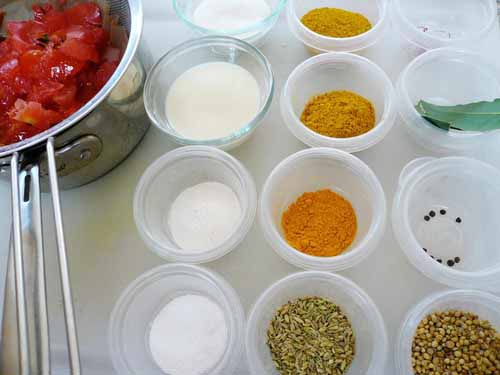
All the more to make a pungently complex curry, my dear…
I combined the curries, turmeric, fennel, bay leaves, coriander, saffron and pepper in a pan and heated, to release their aromatic oils.
Then I added the tomato water, cream, sugar, agar agar and brought to a simmer. Whisking constantly, I boiled the curry for about five minutes are so, until it started thickening up.
I removed it from the heat, let cool a bit, then strained the curry into a stainless bowl.
I refrigerated until it set up.
Then blended smooth in my Cuisinart mini food processor, adding a bit of tomato water to thin out.
And reserved to a plastic container, and reserved to the fridge.
Ingredients
Sweet curry powder
Hot curry powder
Turmeric powder
Fennel seed
Fresh bay laurel leaves, from my garden
Coriander seed
Black peppercorns
Saffron threads
Reserved tomato water
Alta-Dena heavy cream
C&H cane sugar
Agar agar, from L’Epicerie
Morton’s kosher salt, to taste
Crumb Rock — Day Two
After I made it, I tasted it. Waaay too salty. I’d suggest not adding ANY salt. It entirely depends on how salty your olives are to begin with: once they dehydrate, the salt is intensified. I crunched up the baked bread slices and mixed in a stainless bowl with the dried olives, dried garlic chips, chili flakes and pepper. (But as I said earlier, I’d recommend NOT adding any salt just yet. Wait until you grind it all up, then taste.)
Added it to my Cuisinart mini food processor and pulsed, adding a touch of olive oil, into a rough, damp mix.
Then packed into vacuum bags, rolling up to make a “log” shape, sealed up on high, and then froze.
To be Continued…
Next, TOMATO, Balloon of Mozzarella, Many Complementary Flavors (Part 2)
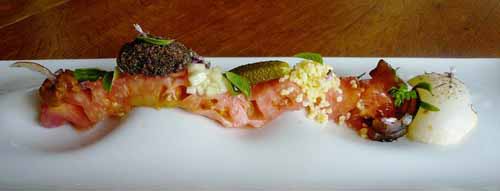
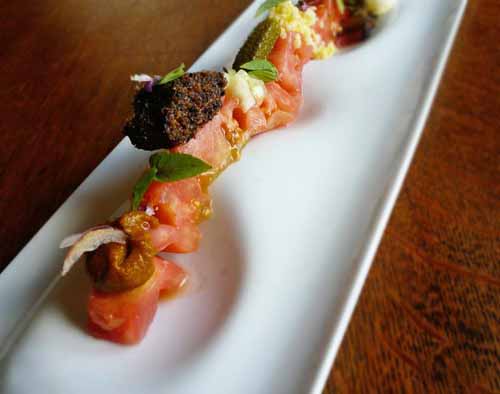
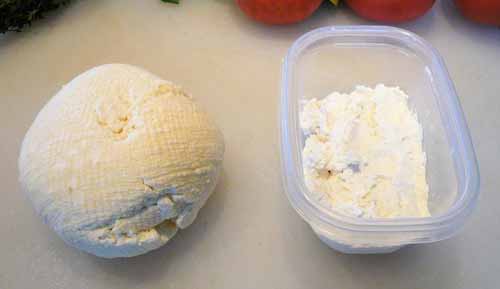

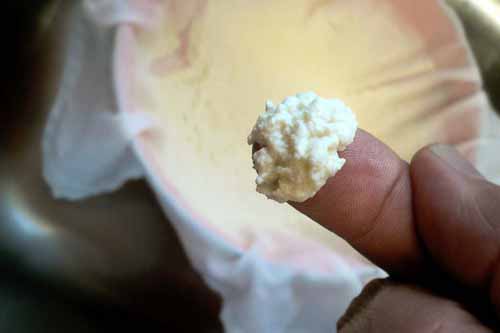
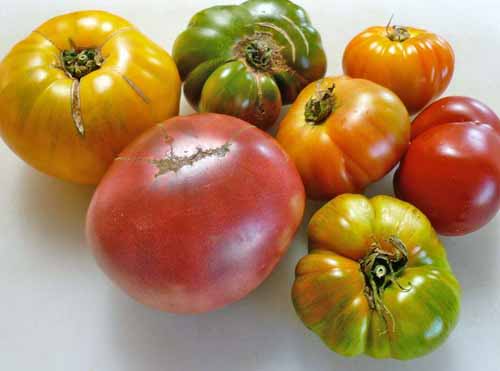

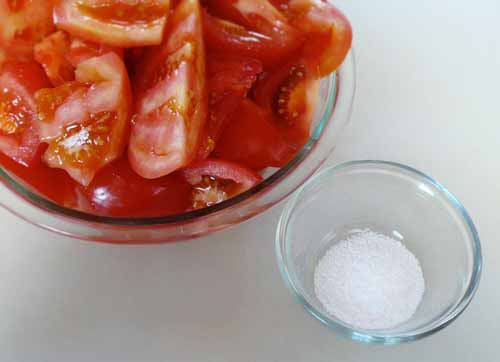
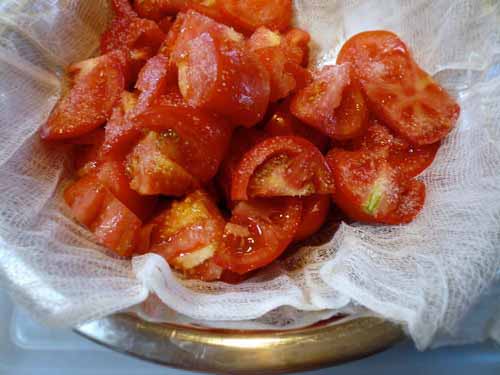


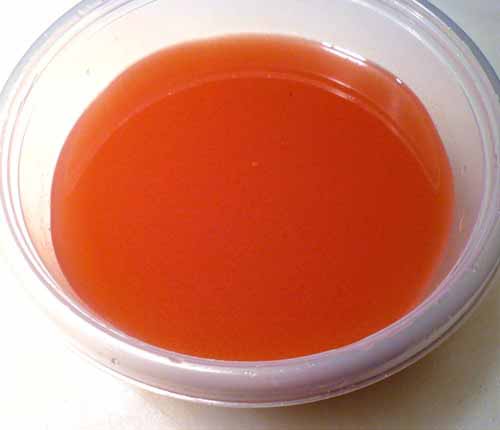

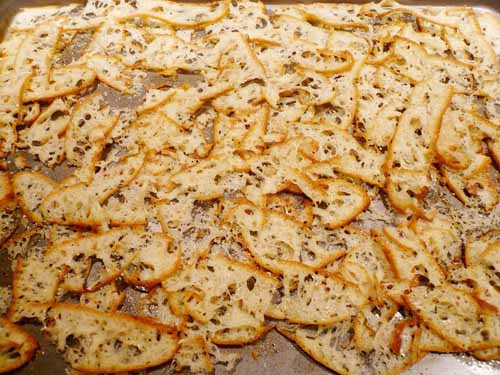



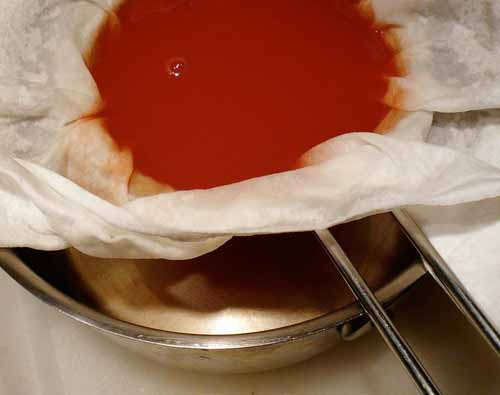


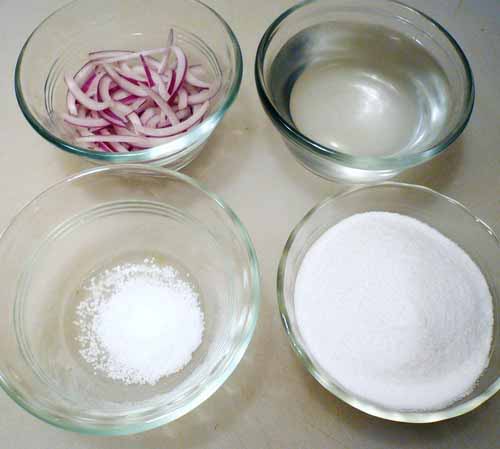
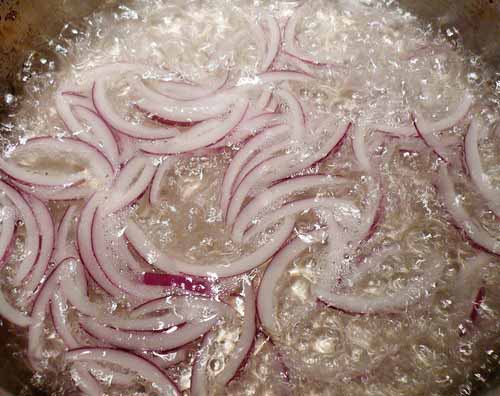
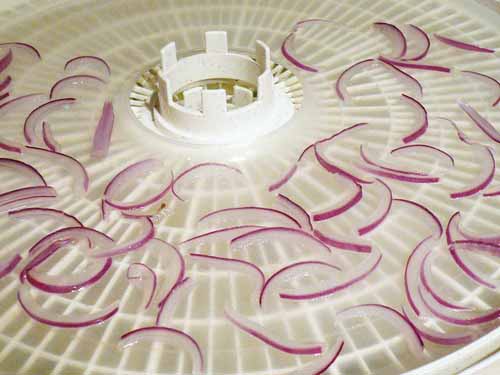
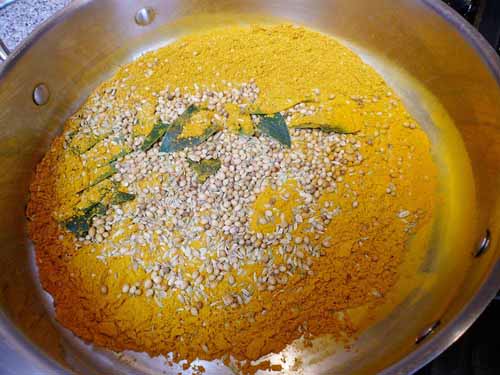

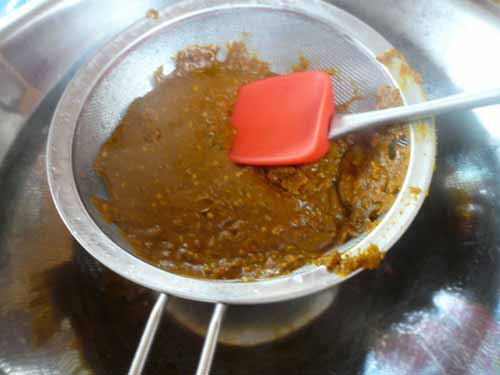





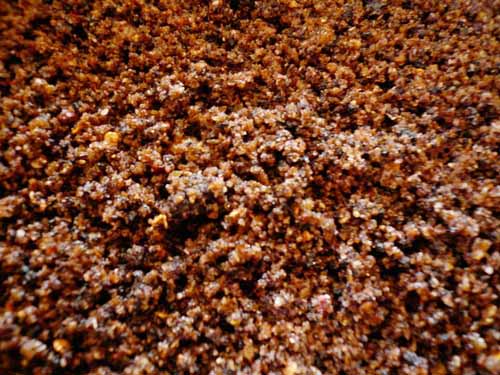

Pingback: Next Restaurant Recipe - Paris 1906 - Pommes de Terre à la Dauphinoise